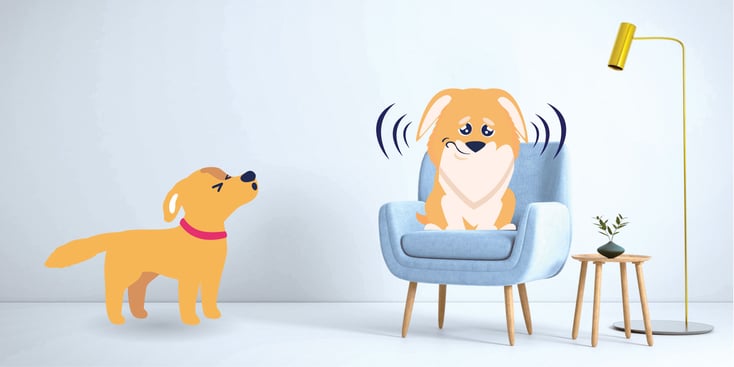Ear Infections in Dogs: Symptoms, Causes, & Treatment

Table of Contents
Ear infections are common in dogs; it is estimated that up to 20% of the dog population have some form of ear disease.
Ear infections are irritating for your dog and sometimes painful, so it is important to know the signs to look out for to make sure that your dog can be treated as quickly as possible.
Key Takeaways:
- Dog ear infections are caused by bacteria and/or yeast overgrowth in the ear canal.
- Treatment for ear infections usually involves topical antibiotics and anti-inflammatories in the form of ear drops.
- Seek veterinary advice if your dog shows symptoms of an ear infection to ensure proper diagnosis and treatment.
What Is a Dog Ear Infection?
A dog ear infection is an overgrowth of bacteria and/or yeast within the ear canal that often results in a build-up of waxy discharge. Dogs are more susceptible to ear infections than humans are because of the “L” shape of their ear canal. Depending on the cause, a dog might develop an ear infection in just one ear or both ears at the same time.
There are three types of dog ear infections affecting the different parts of the ear:
- Otitis externa is the most common type and refers to an outer ear canal infection.
- Otitis interna is an infection of the inner ear.
- Otitis media is an infection of the middle ear.
Otitis media and otitis interna can be very serious and are usually the result of infection spreading from the outer ear canal.
This is why it is important to learn to spot the signs of an ear infection quickly and get it treated early.
What Causes Ear Infections in Dogs?
Common causes of ear infections in dogs include allergies, skin conditions, ear mites, and a build-up of wax. Dogs that spend a lot of time in water are also more likely to develop ear infections. They can also occur as a result of excessive ear cleaning.
Signs & Symptoms of Dog Ear Infections
There are several telltale signs that your dog may be experiencing an ear infection, including the following symptoms:
- Excessive scratching of one or both ears
- Rubbing the side of their face, either along the floor or with their paw
- A smelly discharge
- Excessive head shaking
- Redness of the inside of the ear
- The ear feels hot to touch
- Scabs inside the ear
Middle and inner ear infections can cause more serious symptoms such as:
- A one-sided head tilt
- Vomiting or nausea
- Loss of balance
- Deafness
Some of these may not always be a sign of an ear infection in your dog. Foreign material, such as a grass seed or piece of stick, can sometimes get stuck in the ear canal. Certain breeds are more prone to foreign bodies in their ears, particularly Spaniels and other breeds with floppy ears.
This can be intensely irritating for a dog and will often result in aggressive head shaking, ear scratching, or sometimes even a head tilt. Left untreated, a foreign object down the ear can result in an ear infection or, worse, damage to the eardrum.
Should My Pet Be Seen by a Veterinarian?
1. Have you noticed changes in your pet’s appetite?
2. Does your pet have diarrhea or loose stools?
3. Have you noticed changes in your pet’s thirst/water consumption?
4. Is your pet having accidents in the house?
5. Is your pet pacing and unable to settle?
6. Is your pet panting more than usual?
7. Is your pet whining or vocalizing more than usual?
8. Is your pet shaking more than usual?
9. Is your pet hiding or avoiding physical contact more than usual?
10. Is your pet more lethargic and sleeping more than usual?
11. Are you concerned about changes in your pet’s behavior?
12. Is your pet scratching their ears?
13. Is your pet licking their paws more than usual?
14. Does your pet have a rash?
15. Is your pet moving more slowly than usual or having a harder time getting up or down?
View Results
Should My Pet Be Seen by a Veterinarian?
1. Have you noticed changes in your pet’s appetite?
2. Does your pet have diarrhea or loose stools?
3. Have you noticed changes in your pet’s thirst/water consumption?
4. Is your pet having accidents in the house?
5. Is your pet pacing and unable to settle?
6. Is your pet panting more than usual?
7. Is your pet whining or vocalizing more than usual?
8. Is your pet shaking more than usual?
9. Is your pet hiding or avoiding physical contact more than usual?
10. Is your pet more lethargic and sleeping more than usual?
11. Are you concerned about changes in your pet’s behavior?
12. Is your pet scratching their ears?
13. Is your pet licking their paws more than usual?
14. Does your pet have a rash?
15. Is your pet moving more slowly than usual or having a harder time getting up or down?
Share Quiz
How Are Dog Ear Infections Diagnosed?
If you are concerned that your dog might have an ear infection, then book an appointment with a veterinarian. He or she will use a special instrument called an otoscope to examine your dog’s ear canal. This allows your veterinarian to visualize your dog’s entire ear canal. They will be able to check whether your dog has any foreign objects stuck down his ear, as well as whether or not his eardrums are intact.
Dogs that have very painful ears, or do not tolerate the otoscope examination, may need to be sedated to be examined fully. If your dog does have an ear infection, your veterinarian might suggest taking a swab of the ear canal for it to be cultured. This provides information on what type of ear infection your dog has and which antibiotic will be the most effective.
How Are Ear Infections in Dogs Treated?
Most dog ear infections require topical antibiotics and anti-inflammatories in the form of ear drops. There are many different types of ear drops for dogs. Some need daily or twice daily application for several days whereas others just require a one-off application. Your veterinarian will be able to discuss the different options with you.
Related reading: 3 Home Remedies for Treating Ear Infections in Dogs
If the ear infection is particularly bad, if your dog is in a lot of pain, or there is a lot of wax in the ear canal, your veterinarian might suggest that your dog is anesthetized to have his ear canal flushed. For severe ear infections or infections of the middle or inner ear, your dog might require oral antibiotics and anti-inflammatories in addition to or instead of topical ear medication.
If ear infections are not treated, they can eventually lead to a ruptured eardrum, which can be very painful. This can subsequently lead to a more serious middle or inner ear infection. This is why it is very important to get your dog checked out by a veterinarian if he has any symptoms of ear disease.
How to Prevent Ear Infections in Dogs
One of a dog's most common causes of ear infections is water getting into the ears. If your dog regularly swims or gets wet, be sure to dry his ears thoroughly with a clean towel. Your vet may recommend an ear-cleansing solution that helps dry the ear canals, which can be applied after swimming. If your dog regularly develops ear infections after swimming, then it might be necessary to stop him from swimming altogether.
If your dog is prone to recurrent ear infections, then talk to your veterinarian about possible underlying causes such as dog allergies. Managing any underlying conditions can help prevent your dog from developing ear infections. Regular ear cleaning can sometimes help prevent ear infections, but over-cleaning can also cause ear infections to develop. For this reason, always seek veterinary advice before cleaning your dog’s ears.
Related reading: How to Clean a Dog's Ears at Home: 10 Easy Steps
Conclusion
Dog ear infections are common and can be very painful. Various symptoms may indicate that your dog has an ear infection, including excessive ear scratching or head shaking, hot or smelly ears, or ears that are very waxy.
Always seek veterinary advice if you are concerned that your dog has an ear infection, as not only are they very painful but they can also lead to more serious symptoms such as a head tilt, loss of balance, or deafness.






